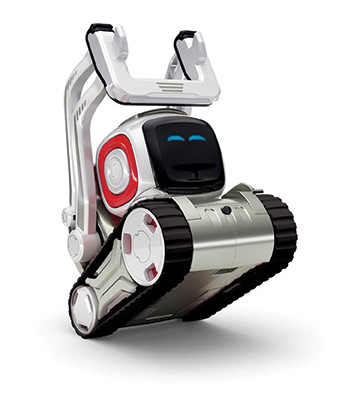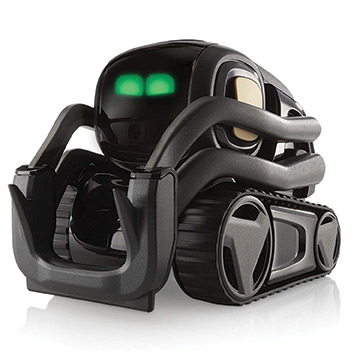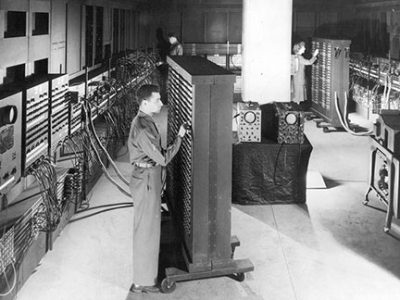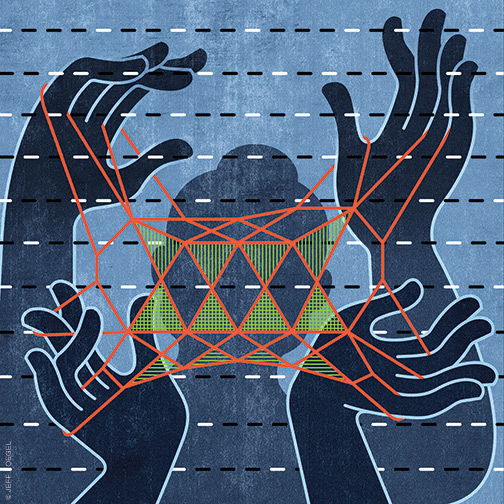
Designing robots with a touch of personality.
So, Mark Palatucci EAS’00 wants to put a robot in every home.
That might sound familiar. After all, you may even already have one. But Palatucci, a cofounder of the San Francisco-based robotics company Anki, isn’t thinking about task-oriented automatons or self-directed vacuum cleaners. He’s not even thinking about smart speakers. He’s designing robots with “character”—enough to spark an emotional connection with their owners.
“People are much more willing to put a character in their home than they are just some smart cylinder or smart speaker that doesn’t have any emotion or character built around it,” he says. “It creates a sense of trust that a lot of other products don’t necessarily have.”
And if that trust leads to more engagement with the robot—whether it’s playing games with a robot called Cozmo, or getting Vector, another model, to take a picture when your hands are full—all the better.
Anki’s aim in building robots is to enable people to “build relationships with technology that feel a little more human.” Palatucci, who earned a computer science and engineering degree at Penn, is the company’s head of cloud artificial intelligence and machine learning. Their products have been getting notice.

Cozmo—which WIRED called “the smartest, cutest AI-powered robot you’ve ever seen”—was the best-selling toy by revenue on Amazon in the United States, the United Kingdom, and France in 2017, according to the market analytics firm One Click Retail. Its main feature is game playing, but you can also learn coding through Cozmo, which uses facial recognition to learn people’s names.
In 2018, Fast Company named Anki as one of the most innovative robotics companies for the fourth year in a row. And late in 2018, Anki launched Vector, which Robotics Business Review said is “straddling the line between pet robot and personal assistant.” Like Cozmo, it runs around the room like a battery-operated toy, lighting up and making sounds. But it can also respond to voice commands to take a photograph or report the weather, or play blackjack with you. And it connects with Amazon Alexa.
Which isn’t to say that Anki and Palatucci have gotten only raves. The Wall Street Journal’s personal technology reporter concluded that Vector “isn’t a very good toy”—but added that it “feels like a beachhead for something bigger.”
Palatucci’s interest in robotics didn’t peak until after he earned his bachelor’s degree, but he credits Penn’s Engineering Entrepreneurship program for preparing him to be a business owner.
“It fundamentally gave just a little bit of a hook into this world that I didn’t know anything about,” says Palatucci, explaining that there weren’t entrepreneurs in his family. “Frankly, if I hadn’t gone through that program, I never would have thought of starting my own company.”

Another boost came just after Penn, when he headed to Silicon Valley to work on early mobile devices. For fun, he joined a team from Stanford University that competed in the DARPA Urban Challenge in 2004. (DARPA is the Defense Advanced Research Projects Agency, the central research and development organization for the US Department of Defense.) The contest required teams to build an autonomous vehicle capable of driving in traffic, performing complex maneuvers such as merging, passing, parking, and negotiating intersections. Palatucci has a vivid memory of his team’s entry traversing its first mile on the 144-mile desert course.
“I remember it feeling very much like this moon shot,” he says. “It was an epiphany for me that robotics and AI were going to have this absolutely massive impact.”
That experience helped push him to pursue a master’s and PhD in robotics at Carnegie Mellon University. Anki launched in 2011.
Palatucci and the company’s two other cofounders—Carnegie Mellon classmates Boris Sofman and Hanns Tappeiner—felt that the robotics industry was focused mostly on industrial and government use cases, rather than on consumers, and they decided to fill that gap.
“When we started the company, it was really about, how do we take these technologies that are having a huge impact in all of these other domains, and can we make an impact on consumer applications?” Palatucci says. “For us, one of the long-term goals was to get to a place where robots are actually helping out people in their everyday lives.”
But he thinks that calls for creating robots that make emotional attachments with people, not robots that just autonomously clean the floor.
Palatucci says Anki approached “character,” as he puts it, in a fundamentally different way from competitors. They were driven by the conviction that, as important as engineers and AI people are to the process, they don’t know how to create a character. So Anki hired experts: people from the feature film industry, including some from the DreamWorks and Pixar animation studios.
“We’ve built out, I think, what is really the world’s first pipeline from feature film animation tools to low-level robotic control,” he says.
“The robot will feel much more alive and much more organic and much more believable as a character because it’s able to perform a basic motion like making eye contact,” Palatucci says. “That has a very, very huge impact on being able to create that sense of magic and really being able to create the sense that this character is alive and emotive.”
Palatucci points to Anki customers who have written to the company praising the social benefits of their robots: families spending time together interacting with the robot, as they might with a board game; or a child who didn’t have many friends now inviting other kids over to play with the robot.
“I definitely think that this is a space that is only going to continue to grow,” Palatucci says, “particularly as the prices of these technologies come down and the features and the behavior get more and more sophisticated.”
—Tom Kertscher




